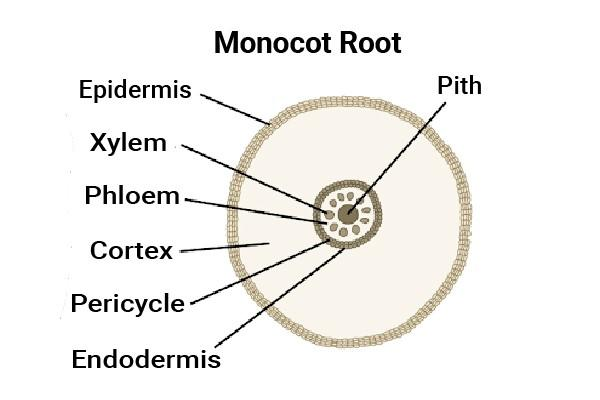
A typical monocotyledonous root is characterized by
A. Usually more than six xylem bundles
B. Large and well-developed pith
C. No secondary growth
D. All of the above
Answer
497.4k+ views
Hint: The roots of monocots cannot grow in diameter due to the lack of vascular cambium. In dicots, there is secondary growth which makes the plants have woody stems.
Complete answer: Monocot roots are characterized by the presence of (8 or more in number) alternate and radial xylem and phloem bundles.
This condition of the xylem is known as polyarch condition.
The central portion of the cross-section of a monocot root is occupied by a large pith consisting of thin-walled parenchyma cells spaced with intercellular spaces.
These cells may be round or angular in shape and are filled with abundant starch grain.
The vascular bundles are arranged in the form of a ring around the well-developed central pith.
Monocots don’t undergo secondary growth throughout their life cycle, instead, they grow more roots at the shoot and send out typical creeping shoots known as runners or rhizomes.

So, the correct answer is option D. All of the above.
Note: There is no distinction between a young and an old root of the monocotyledonous plant. This is due to the absence of secondary growth in the monocot roots.
Complete answer: Monocot roots are characterized by the presence of (8 or more in number) alternate and radial xylem and phloem bundles.
This condition of the xylem is known as polyarch condition.
The central portion of the cross-section of a monocot root is occupied by a large pith consisting of thin-walled parenchyma cells spaced with intercellular spaces.
These cells may be round or angular in shape and are filled with abundant starch grain.
The vascular bundles are arranged in the form of a ring around the well-developed central pith.
Monocots don’t undergo secondary growth throughout their life cycle, instead, they grow more roots at the shoot and send out typical creeping shoots known as runners or rhizomes.

So, the correct answer is option D. All of the above.
Note: There is no distinction between a young and an old root of the monocotyledonous plant. This is due to the absence of secondary growth in the monocot roots.
Recently Updated Pages
Master Class 12 Business Studies: Engaging Questions & Answers for Success

Master Class 12 English: Engaging Questions & Answers for Success

Master Class 12 Social Science: Engaging Questions & Answers for Success

Master Class 12 Chemistry: Engaging Questions & Answers for Success

Class 12 Question and Answer - Your Ultimate Solutions Guide

Master Class 12 Economics: Engaging Questions & Answers for Success

Trending doubts
The gas that burns in oxygen with a green flame is class 12 chemistry CBSE

Most of the Sinhalaspeaking people in Sri Lanka are class 12 social science CBSE

Give 10 examples of unisexual and bisexual flowers

Draw a labelled sketch of the human eye class 12 physics CBSE

Differentiate between homogeneous and heterogeneous class 12 chemistry CBSE

Write a short note on Franklands reaction class 12 chemistry CBSE




